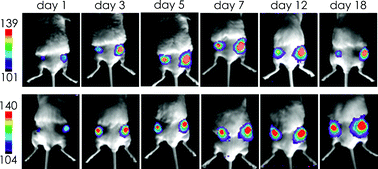A redshifted codon-optimized firefly luciferase is a sensitive reporter for bioluminescence imaging
Abstract
Bioluminescence imaging has evolved as a powerful tool for monitoring biological processesin vivo. As transmission efficiency of light through tissue increases greatly for wavelengths above 600 nm we examined whether a redshifted codon-optimized firefly luciferase (λmax = 615 nm) could be successfully employed as a sensitive reporter in mammalian cells. To this end, unmodified codon-optimized luciferase (λmax = 557 nm) as well as the red-emitting S284T mutant luciferase were expressed simultaneously in human glioma cellsin vitro as well as in quadriceps muscles of mice in vivo. We show here that activity of the redshifted enzyme in human glioma cell culture approached approximately one-fourth of that seen with the unmodified enzyme. In contrast, light emission by the red-emitting luciferase in vivo was generally more efficient than that produced by its unmodified counterpart, most likely due to reduced absorption of red light by tissue. The mean ratio of light emission produced by the redshifted luciferase to that of the unmodified enzymein vivo was ∼3. Application of this new redshifted luciferase together with other optical reporters may be of considerable importance to biological research as it allows for imaging of deeper tissues as well as simultaneous monitoring of two molecular events in vitro and in vivo if appropriate filter sets are employed.


 Please wait while we load your content...
Please wait while we load your content...